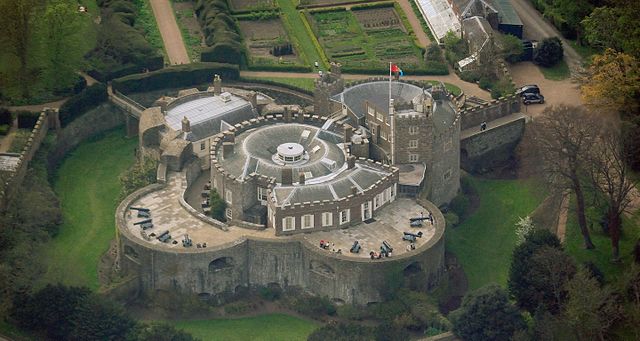Walmer Castle is an artillery fort originally constructed by Henry VIII in Walmer, Kent, between 1539 and 1540. It formed part of the King's Device programme to protect against invasion from France and the Holy Roman Empire, and defended the strategically important Downs anchorage off the English coast. Comprising a keep and four circular bastions, the moated stone castle covered 0.61 acres (0.25 ha) and had 39 firing positions on the upper levels for artillery. It cost the Crown a total of £27,092 to build the three castles of Walmer, Sandown, and Deal, which lay adjacent to one another along the coast and were connected by earthwork defences. The original invasion threat passed, but during the Second English Civil War of 1648–49, Walmer was seized by pro-Royalist insurgents and was only retaken by Parliamentary forces after several months' fighting.
The castle from the east in 2018
A 1539 early design for either Walmer or nearby Sandown Castle
Aerial view of the castle seen from the north-east, showing the later alterations to the upper storeys, with the gatehouse to the upper right
A satirical cartoon of 1805, depicting William Pitt the Younger directing operations against the French from Walmer Castle (left)
Walmer is a town in the district of Dover, Kent, in England. Located on the coast, the parish of Walmer is six miles (9.7 km) south-east of Sandwich, Kent. The town's coastline and castle are popular amongst tourists. It has a population of 6,693 (2001), increasing to 8,178 at the 2011 Census.
Walmer Castle
A modern monument marking the site of the former World War I and II airfield located near the Kentish coastal town of Walmer.
A monument to the Roman conquest of Britain, in Walmer







